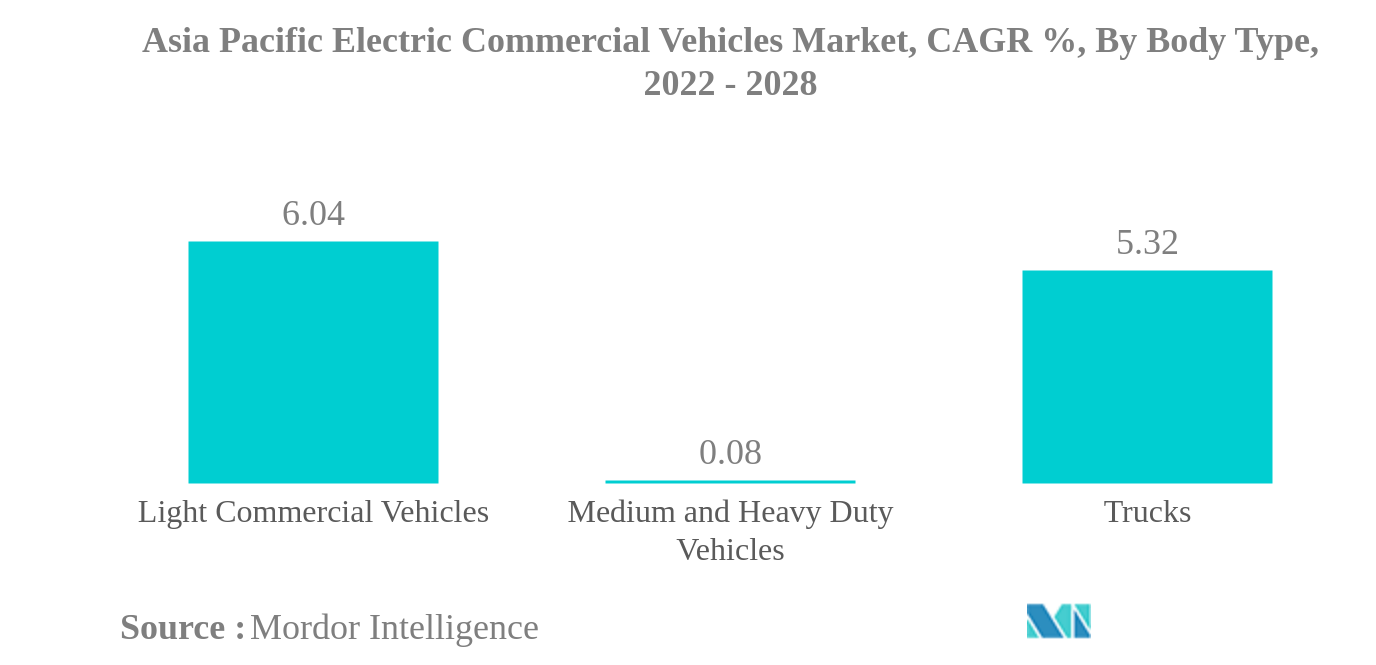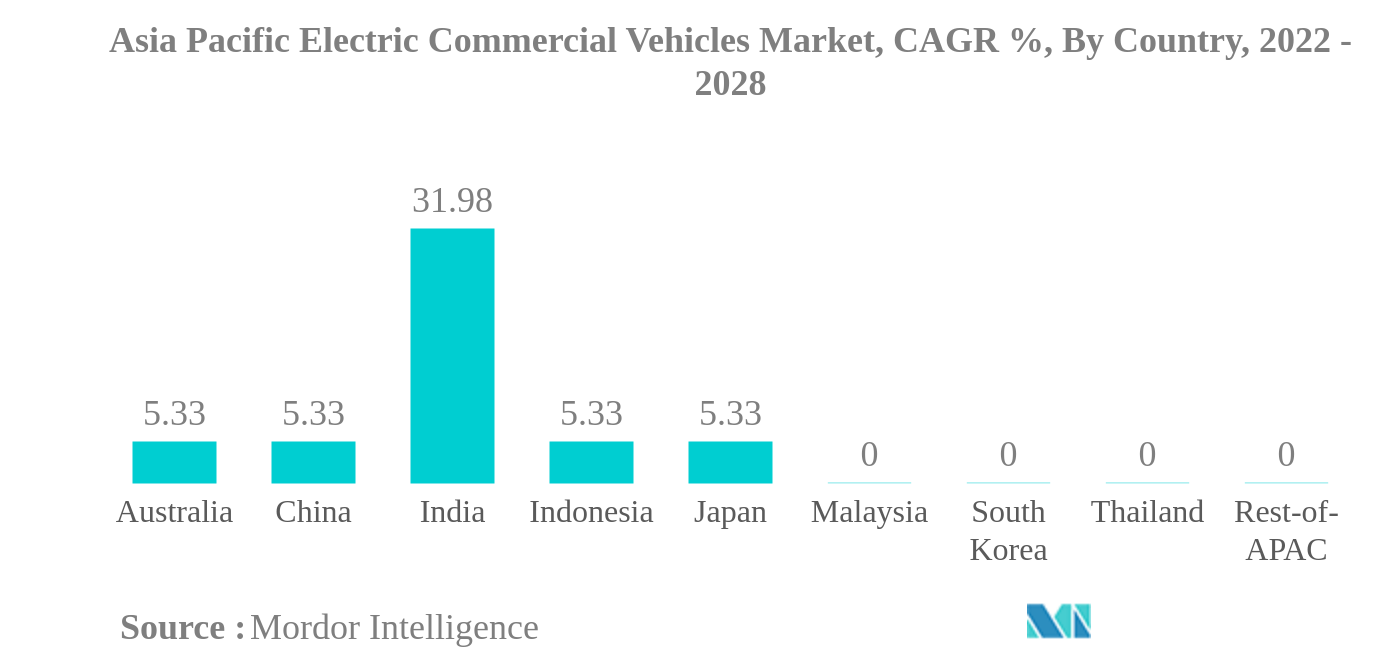Market Trends of asia pacific electric commercial vehicles Industry
This section covers the major market trends shaping the APAC Electric Commercial Vehicles Market according to our research experts:
Trucks is the largest segment by Body Type.
- The APAC hybrid and electric commercial vehicles market is expected to grow from USD 15.42 billion in 2021 to USD 24.76 billion by 2028 at a rate of 8.28%. Companies are investing in zero-emission vehicle technologies to gain an early advantage in the electrification race.
- Aside from electrification, local players are also working on testing and application of autonomous commercial vehicles. For instance, in February 2021, Qingling Motors (Group) Co. Ltd announced that the L3 5G autonomous logistics vehicle, developed jointly with the Chongqing University of Posts and Telecommunications, was granted Chongqing’s first commercial vehicle license for open autonomous driving tests. The vehicle carries the battery electric chassis of Qingling Motors’ EV700 and uses various advanced technologies, such as high-precision vision sensors, a 360-degree surround view system, and an artificial intelligence control algorithm.
- Major players in the region are collaborating to develop and manufacture electric trucks. For instance, in October 2020, BYD Auto and Hino Motors announced that they are jointly setting up a company to develop battery-powered trucks and buses. BYD Auto Industry Co., a unit of battery producer BYD Ltd, and Hino Motors Ltd said each would supply 50% of the investment required for the company. Their first model was expected to be launched in 2021.
- Owing to the aforementioned developments, the market for commercial electric vehicles is expected to witness the entry of new companies in the coming years, which may propel the overall growth of the commercial vehicle market in the region over the forecast period.

China is the largest segment by Country.
- The initiatives taken by governments across the world to adopt green energy mobility in order to curtail and curb transportation pollution are among the key factors that are projected to drive the fuel cell commercial vehicle market in the near future. In November 2019, the government-backed Chinese business, Beiqi Foton Motor, a truck and bus manufacturer, announced that it would invest USD 2.6 billion in alternate energy vehicles, including fuel cell engines. The company plans to deploy 200,000 new energy commercial vehicles by 2025.
- Several major OEM players are investing heavily in research and development, and they entering strategic partnerships to enhance their technologies for commercial vehicles. In January 2020, Japan's Honda Motor and Isuzu Motors announced that they would jointly conduct research on the use of hydrogen fuel cells to power heavy-duty trucks, looking forward to expanding fuel-cell usage by applying zero-emission technology to larger vehicles. Such developments are expected to enhance the electric commercial vehicles market across the APAC region.
- In 2020, South Korea extended the purchase subsidy for electric vehicles for passenger cars until 2024, and for buses and trucks, it was extended until 2025. The bonus is tied to a price cap. EVs priced below KRW 60 million are eligible for full subsidies, but vehicles priced between KRW 60 million and 90 million may receive only 50% of the full amount. Previously, up to KRW 8 million in subsidies were available per vehicle.

APAC Electric Commercial Vehicles Market Report - Table of Contents
-
1. EXECUTIVE SUMMARY & KEY FINDINGS
-
2. REPORT OFFERS
-
3. INTRODUCTION
-
3.1 Study Assumptions & Market Definition
-
3.2 Scope of the Study
-
3.3 Research Methodology
-
-
4. KEY INDUSTRY TRENDS
-
4.1 Population
-
4.2 GDP
-
4.3 CVP
-
4.4 Inflation Rate
-
4.5 Interest Rate For Auto Loans
-
4.6 Battery Price (per Kwh)
-
4.7 Logistics Performance Index
-
4.8 Electrification Impact
-
4.9 New XEV Models Announced
-
4.10 Charging Stations Deployment
-
4.11 Regulatory Framework
-
4.12 Value Chain & Distribution Channel Analysis
-
-
5. MARKET SEGMENTATION
-
5.1 Sub Body Type
-
5.1.1 Buses
-
5.1.2 Heavy-duty Commercial Trucks
-
5.1.3 Light Commercial Pick-up Trucks
-
5.1.4 Light Commercial Vans
-
5.1.5 Medium-duty Commercial Trucks
-
-
5.2 Fuel Type
-
5.2.1 BEV
-
5.2.2 FCEV
-
5.2.3 HEV
-
5.2.4 PHEV
-
-
5.3 Country
-
5.3.1 Australia
-
5.3.2 China
-
5.3.3 India
-
5.3.4 Indonesia
-
5.3.5 Japan
-
5.3.6 Malaysia
-
5.3.7 South Korea
-
5.3.8 Thailand
-
5.3.9 Rest-of-APAC
-
-
-
6. COMPETITIVE LANDSCAPE
-
6.1 Key Strategic Moves
-
6.2 Market Share Analysis
-
6.3 Company Landscape
-
6.4 Company Profiles
-
6.4.1 BYD Company Limited
-
6.4.2 Daihatsu Motor Co. Ltd
-
6.4.3 Dongfeng Motor Corporation
-
6.4.4 Fiat Chrysler Automobiles
-
6.4.5 Ford Motor Company
-
6.4.6 Hino Motor Ltd
-
6.4.7 Honda Motor Company
-
6.4.8 Hyundai Motor Company
-
6.4.9 Isuzu Motors Ltd
-
6.4.10 Mahindra & Mahindra
-
6.4.11 Mitsubishi
-
6.4.12 Scania AB
-
6.4.13 Tata Motors
-
6.4.14 Toyota Motor Corporation
-
6.4.15 Zhengzhou Yutong Group Co. Ltd.
-
-
-
7. KEY STRATEGIC QUESTIONS FOR VEHICLES CEOS
-
8. APPENDIX
-
8.1 Global Overview
-
8.1.1 Overview
-
8.1.2 Porter's Five Forces Framework
-
8.1.3 Global Value Chain Analysis
-
8.1.4 Market Dynamics (DROs)
-
-
8.2 Sources & References
-
8.3 List of Tables & Figures
-
8.4 Primary Insights
-
8.5 Data Pack
-
8.6 Glossary of Terms
-
